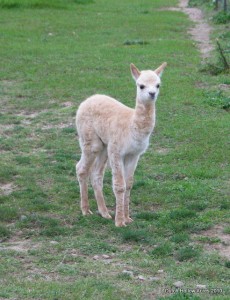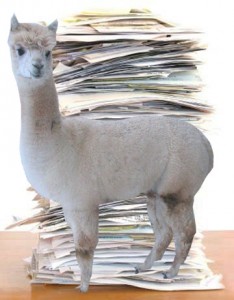
Where do they come up with those prices for alpacas and alpaca products? To be perfectly honest, I have NO clue. No one appears to be following the rules of business and the alpaca industry has been inflated for quite some time because of it. Thankfully with the recent economy troubles things are correcting themselves and alpaca sales are starting to fall in with the rest of the livestock industry. Let’s look into why we are pricing the way we do.
Making the Money
To make a long story short you’re thinking about getting into the alpaca business to make $$$. You have dreams of telling your current boss to shove it, kick off your loafers and slap on a pair of muck boots. This means you need to price your goods and services in such a manner that you can be profitable. You need to be able to cover not only to costs of farm operation but to also cover your living expenses and put some in your pocket, PROFIT!
You might think that the cost of an item is what determines its ability to sell. WRONG! Ultimately you are the reason an item sells not the sticker you put on it. But what price should you put on that sticker?
Under pricing – Bad idea all around. Not only are you pricing items such that you no longer can be profitable but your clientele also changes. You might be thinking but we’re in a recession, people are pocket pinching and I should lower my prices so I’m the lowest of them and its ok that I lose $ because I’ll have a higher volume in sales. *Buzzer* Your customer base which you’ve marketed to before now sees you as potentially going out of business, unreliable, and possibly selling an inferior product than your competitors.
Over Pricing – Well fine, if you can’t be the cheapest let’s be the most expensive. High cost = Quality right? Nope. Your customers are bargain shoppers but if you’re priced so ridiculously over the same thing your competitor is selling they’ll just think you’re a pocket picker. When you end up looking at expenses you need to cover you might think your prices have to be very high just to cover overhead but don’t forget that that price might be too high for what someone is willing to actually pay or what they perceive as “fair.”
The Price is Right
There are many factors that go into setting your price. There is a lot of homework that goes into understanding why an item is priced the way it is. It is probably best to even look at your local college or university to see if they have courses to help you along the way. The key is to never forget why you are in business. You are there to fill the need/want/desire your customer has and the more you know about your customer the more profit you will be able to make.
Know Your Customer. Know your Competition
It is important to know who your customers are and what they value. You can obtain this information through simple statistical research like the census bureau, through surveys direct to your customer base, becoming your customer, and checking out your competition. There is a reason why marketing budgets are so high for companies, no marketing = no sales. Once you figure out who you’re selling to, you can price to fit them. For example; If you’re marketing to young new parents who, just bought a home, have 2 kids and a dog they probably are not willing to spend $30 on a pair of socks. But, if you’re marketing to middle aged men who are into hunting they are happy to shell out $20-30 for a pair of socks that will keep their feet warm so they can stay in that tree stand longer.
Costs
There’s no way around it, you won’t be able to make a profit unless you bring in enough money to cover your costs. In the case of us alpaca ranchers your costs are happily itemized out on your Schedule F form. Your Schedule F is your Overhead cost and can include both fixed and variable costs. Believe it or not every ounce of your Schedule F goes into determining why you’re pricing a pair of alpaca socks the way you are.
What we are ultimately looking for is your MarkUp %. Let’s say a pair of alpaca socks costs you X to make/buy, what is the MU% to sell it at Y so you can make a profit?
MU% Factors
So how do you come to find your MU%?
Expenses – think of everything! Schedule F, living expenses, your salary, outstanding loans, cost of product, etc
Sales Goals – Yup you must set a sales goal. How much do you want to sell this year? If you are just starting out your sales goal will probably be lower than your expenses. But you must set a goal for yourself never the less. Year 1 my goal was $5K Year 2 my goal was $20K for example.
Product Cost – Items that wouldn’t normally go into your Schedule F like wholesale purchases.
Profit – How much profit do you plan on making this year? I’ll be flat out honest with you, I’m year 3 into my alpaca business and my projected profit this year is -$35,000. Yup, I plan on being $35,000 in the hole. It’s not pretty but at least I understand where I am and what I need to do to eventually make a profit. Starting a farm from scratch is very expensive. If you’re looking for a more economical way to get started in alpacas see our post on Agsting.
Reduction% – there is always loss in any business and be sure to keep good records so you understand your losses. They could be anything from the death of an alpaca, several socks in a shipment with a slipped stitch, or moldy hay. If you do not know this % yet it is best to use 5% of our sales goal until you have records to support a different number. Calculating reduction 5% of 100,000 = 5,000
Calculating MU%
MU% = (Expenses + Reduction + Product Cost + Profit) divided by
(Sales Goal + Reduction)
My year 2 MU%
90.5%=($35,000 + $1,000 + $18,000 + -$35,000) / ($20,000 + $1,000)
These are my real numbers for 2010. My goal was not to attempt to cover any of my living expenses and I realized that I am starting out and yes I’m still paying off farm startup costs so minus $35,000 was a realistic “Profit” goal. I was very aggressive in my sales goal and have been working hard at doing $20,000 in sales this year.
Price Tag
So I have my rounded MU% of 90 now what? This is the % you will mark up your products. If it costs you $10 for a pair of socks then you will want to mark it up by 90%. $10 x 90% = $19 Tada! You have just priced your socks!
The same goes for pricing your livestock. You’ll want to take the cost of your dam and divide it by how many cria you plan to get out of her, 10 I think is a fair number, add that with your stud fee and what it costs for 1 year of care and mark that up with your MU% to see what your cria should sell for to make a profit. This is a bit of a cheating method because technically your Dam/Stud/Care is already in your Schedule F but this helps break it out and getting more profit is never a bad thing.
Alpaca Dam = $12,000 / 10 = $1,200
Stud Fee = $3,000
1yr Care = $100
————————
total = $4,300
MU%= 90%
————————
Cria Sale Price = $8,170
Of course you are not obligated to stay at that MU% and in the end it is your customers, competition and ability to sell that will determine your price. You might find that you can price higher than your MU% on some items but have to be lower with others. Be sure not to go to the extremems, too high and too low will cost you ultimately.
Good luck and may the sales be with you!
PST – Check our our Overview Page for other Alpaca Business Articles
